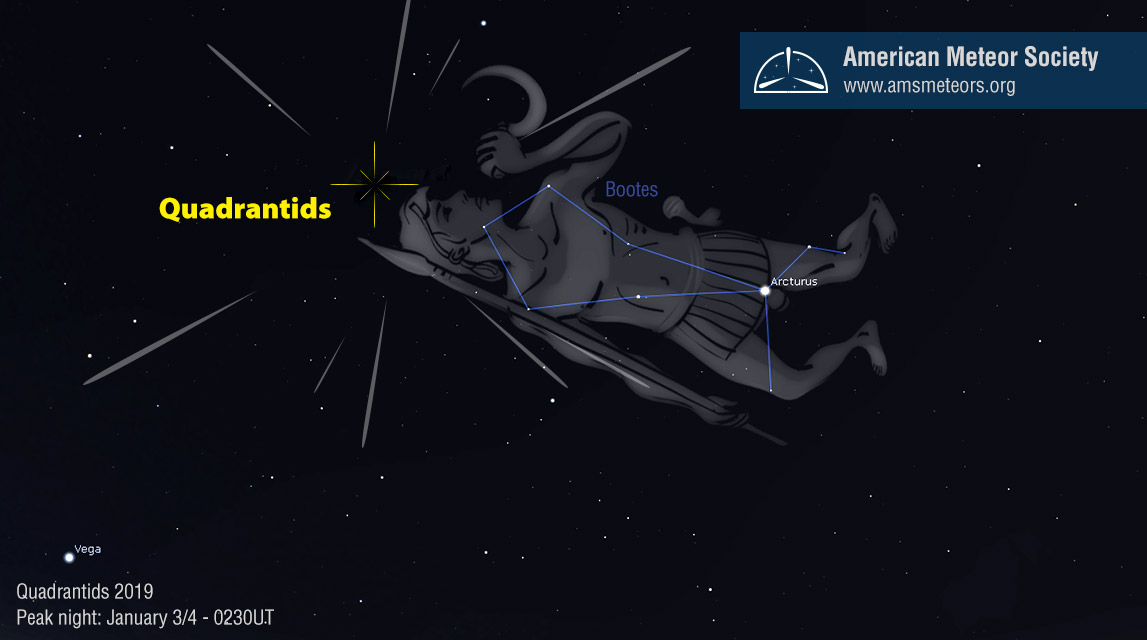The Quadrantids can be one of the strongest displays of the year, yet they are difficult to observe. The main factor is that the display of strong activity only has a duration of about 6 hours. The reason the peak is so short is due to the shower’s thin stream of particles and the fact that the Earth crosses the stream at a perpendicular angle. Unlike most meteor showers which originate from comets, the Quadrantids originate from an asteroid: asteroid 2003 EH1. Asteroid 2003 EH1 takes 5.52 years to orbit the sun once. It is possible that 2003 EH is a “dead comet” or a new kind of object being discussed by astronomers sometimes called a “rock comet.”
The name “Quadrantids” comes from Quadrans Muralis, a former constellation created in 1795 by the French astronomer Jérôme Lalande that is now part of Boötes.
In order to see the Quadrantids at their best they need to reach maximum near 04:00 local standard time so that the radiant lies high in your sky. The early January weather is also a major factor as cloudiness is usually prevalent this time of year. If it is clear then it can also be bitterly cold, making observations uncomfortable at best. In my many years of observing, I have only managed to catch the Quadrantids at maximum once. Despite the strong wind that morning, it was a sight I will never forget as the last two hours before dawn produced in excess of 100 Quadrantids each.
The Earth encounters Quadrantid meteors from December 22 through January 17. Rates are extremely low away from the January 4 maximum. For 2019, the maximum is expected to occur near 02:30 Universal Time (UT) on January 4. This timing favors Europe, Northern Africa, and extreme western Asia. Observers situated in other parts of the world can expect around 25 Quadrantids per hour at best. The moon will not be a factor on January 4th as it is lost in dawn’s glare, too close to the sun to be seen.
The Quadrantid radiant is located in northern Bootes and is best placed highest in a dark sky just before dawn. From mid-northern latitudes the radiant is located low in the northwestern sky at dusk. It’s too low in the sky to bother watching unless you are watching from latitudes 60N or further north. As the night progresses the radiant skims the northern horizon and then begins to rise higher into the northeastern sky. It is best placed during the last hour before dawn when it is located high in the northeastern sky.
These are medium fast meteor comparable to the Lyrids of April. They are slower than the Perseids but faster than the Geminids. While not known to be a fireball source, I have seen Quadrantids as bright as magnitude -10, so the possibility exists that some extremely bright meteors may be seen.

This illustration above depicts the Quadrantid radiant as seen during the morning hours looking northeast. The brilliant star Arcturus is a good guide to this area of the sky. All Quadrantid meteors will trace back to the radiant area located in northern Bootes. From the southern hemisphere the radiant is located much lower in the northern sky therefore rates will be greatly reduced. There are several other minor showers active during this time plus random meteors that will appear in different paths than the Quadrantids with different velocities.
This is your last chance to witness a major meteor display under optimum conditions until early May. If your sky is clear don’t miss this opportunity!



